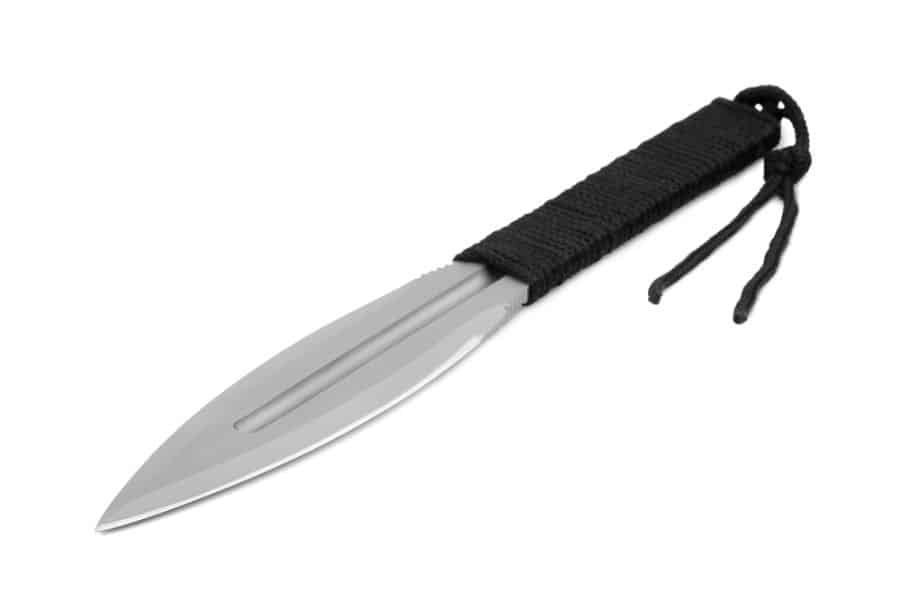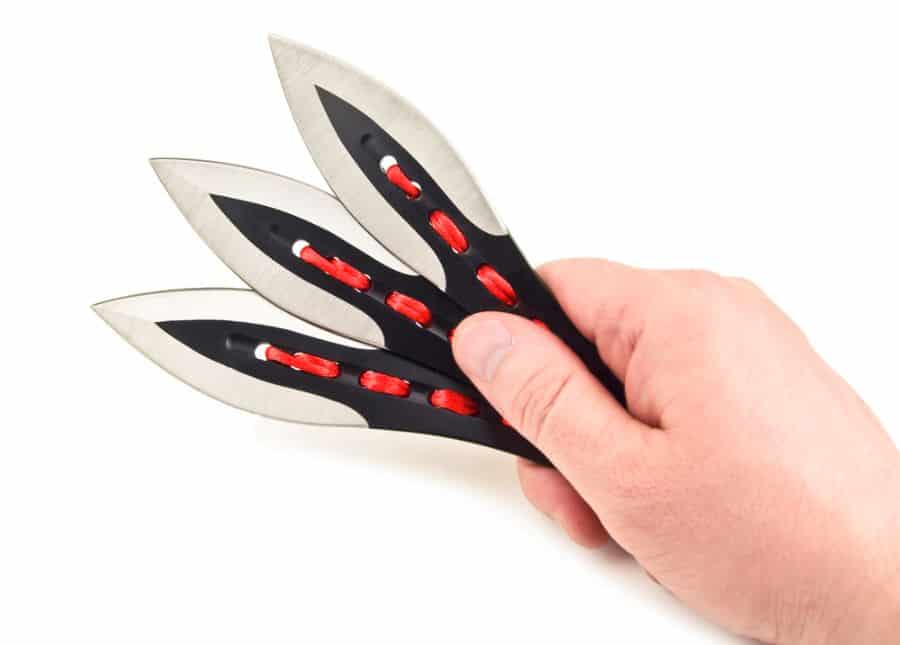Whether you’re a novice shopping around for your first knife set or an experienced knife thrower, there’s one major fundamental truth that all knife throwers understand sooner or later – size does matter. The size of a throwing knife can affect its balance, grip, and overall throwing accuracy.
The best size for throwing knives generally measures between 10 – 12 inches and weighs between 10 – 15 ounces. This ensures the knife’s best performance and makes it easier to aim and penetrate the target.

But with so many different sizes and styles of knives available, how can you choose the best size throwing knives? Is there really a difference? Does the ideal knife size differ from person to person? And if so, how does the overall size of the throwing knife affect performance?
Not to worry. In this post, we will answer all your questions regarding throwing knife size, what to look for when choosing the right knives, and how knife size affects overall performance.
How does Knife Size Affect Throwing Performance?
The larger and heavier the knife, the slower its spin and the heavier its impact on the target. Conversely, the smaller and lighter the knife, the faster it can be thrown.
Knives that are too big are awkward to throw and have too slow of a spin to build up enough speed to penetrate the target adequately. In other words, big knives are slow and clunky. It would be like throwing a flashlight and expecting it to hit the target where aimed (okay, I know that’s an extreme example, but you get the gist of it).
If a knife is too big, it’s slower and unwieldy, making it more difficult to aim. On the other hand, if a knife is too small, it doesn’t have enough weight to adequately penetrate the target and risks ricocheting off the target and potentially causing injury.
While throwing knives generally come in sizes between 6 – 13 inches, the ideal throwing knife is between 10 – 12 inches. Knives that are too large or too small will result in poor performance.
Of course, the ideal size will depend heavily on what you are most comfortable with. A thrower who’s petite with a small frame will generally be comfortable with a smaller knife than a larger, taller thrower.
Makes a lot of sense, doesn’t it? Small thrower = small ideal knife, and vice versa.
Features of Throwing Knives
When considering which throwing knife size is best, it’s easy to forget the knife’s components and focus only on the overall length. But a knife’s size is impacted by several features, including handle, blade, balance, and weight.
Let’s dive in and discuss the features that make up a knife’s length: blade and handle.
Handle
When shopping for throwing knives, you’re bound to notice that there are various designs to choose from. While many have distinct handles – handles that are a separate part attached to the blade – these aren’t the best for throwing knives.
The best throwing knives are a single solid piece of steel, which maintains the knife’s balance and makes it easier to throw. Sometimes the knife’s handle is wrapped in a cord for throwers who desire a bit of extra grip (this is especially true for beginners. Best to have every advantage you can when testing out your skills for the first time!).

When choosing a throwing knife, make sure that the handle fits comfortably in your hand. A comfortable and well-sized grip is vital for aiming.
Always go for a balanced knife at its center, as the best knives will rotate mid-air at this point and develop the smoothest, fastest spin.
If you’re unsure where the knife’s center of gravity is, balance it on your finger and find where it balances best. Ideally, this will be at the knife’s middle – give or take half an inch.
The handle and the blade must have an even weight distribution. This doesn’t mean that the knife must be symmetrical (though many are), but it should be evenly balanced on either side, regardless of the knife’s shape and overall size.
Blade
Some knives have a higher blade-to-handle ratio regarding length or vice versa, but the weight distribution remains the most important factor. It doesn’t matter whether the blade or handle is longer – just as long as there’s proper balance.
When throwing the knife, make sure to make the throw from the knife’s lightest point. This is usually the blade’s tip but can sometimes be the end of the handle.
How to Find the Right Size for Skill Level and Throwing Style?
The skill level and throwing style can be important factors to consider when choosing the size of a throwing knife. Your skill level and throwing style can affect how well you are able to control and throw a knife, and different sizes of knives may be better suited to different levels of skill and different throwing styles.
Skill Level
A beginner who is just starting to learn how to throw knives may find that a smaller knife is easier to control and more suitable for their skill level. A smaller knife may be lighter and more maneuverable, making it easier for a beginner to throw accurately and consistently.
On the other hand, an experienced thrower who has developed a high level of skill and precision may find that a larger knife is better suited to their abilities. A larger knife may have more momentum and power, allowing an experienced thrower to throw the knife with greater force and accuracy.
Throwing Style
Similarly, different throwing styles may be better suited to different sizes of knives. For instance, the overhand throwing style, which involves throwing the knife with a backhand motion, may be better suited to a larger knife because it allows for more power and momentum.
On the other hand, the spin-throwing style, which involves spinning the knife in the air before releasing it, may be better suited to a smaller knife because it allows for greater control and accuracy.
Are there Differently Sized Knives for Men and Women?
Not necessarily. The overall size of the knife depends on what is most comfortable for the thrower. Those with smaller frames and less upper body strength – generally women – have smaller, lighter knives than those with more upper body strength.

But again, it all comes down to what is most comfortable for you. As we all know, people come in all shapes and sizes.
What is the Best Weight for a Throwing Knife?
Because the weight and length of a throwing knife ultimately depend on what’s most comfortable for the thrower, we’ll make it easy to determine the best weight: add between 1 and 1.25 ounces for every inch of length the knife has.
For example, a 10-inch knife should weigh between 10 – 12.5 ounces. Anything less will throw off its center of gravity, make the knife too light to penetrate the target adequately, and run the risk of bouncing off the target’s edge and potentially causing injury.
If the knife is too heavy, it becomes difficult to throw and doesn’t achieve a fast enough spin to launch into the target – or even make it there. You’re much more likely to find a too-heavy knife sticking out of the dirt several feet in front of the target.
What Size Knives do Professional Knife Throwers Use?
Professional knife throwers must adhere to specific guidelines dictated by the World Knife Throwing League. These guidelines are mandatory for knives used in tournament play with no exceptions. For aspects of the knives that heavily depend on the size or strength of the thrower, such as length and weight, there are approved ranges.
- Overall Length: 13.5 – 16 in.
- Guard Width: at least 4 in.
- Cheek Width: no wider than 3.5 in.
- Handle Length: 7 in. maximum
- Max. Weight: 1.65 lbs.
Professional knife throwers must use knives that are equipped with guards – a piece perpendicular to the blade and handle – to prevent the knife from bouncing off the target or surrounding fencing.
Overview: What is The Best Size for Throwing Knives?
Now that we’ve discussed the size and how it affects throwing performance, let’s sum up everything we’ve learned.
- Throwing knives come in various lengths, usually 6 – 13 inches. However, the ideal throwing size is between 10 – 12 inches.
- Choose a knife that’s comfortable for you. Smaller throwers tend to prefer smaller, lighter knives.
- Make sure the knife is properly balanced with even weight distribution.
- If a knife is too small, it might not penetrate the target and may bounce off it instead, potentially causing injury.
- If a knife is too big, it is difficult to throw and won’t achieve the proper mid-air rotation speed. This also increases the likelihood it’ll fall short of the target.
Takeaway
The size of the knife will depend on the individual user, with smaller throwers typically being more comfortable with smaller knives and larger throwers being more comfortable with larger knives. In general, it is important to choose a throwing knife that feels comfortable and easy to grip, as well as one that is well-balanced for accurate throwing. This ensures the knife’s best performance and makes it easier to aim and penetrate the target.

